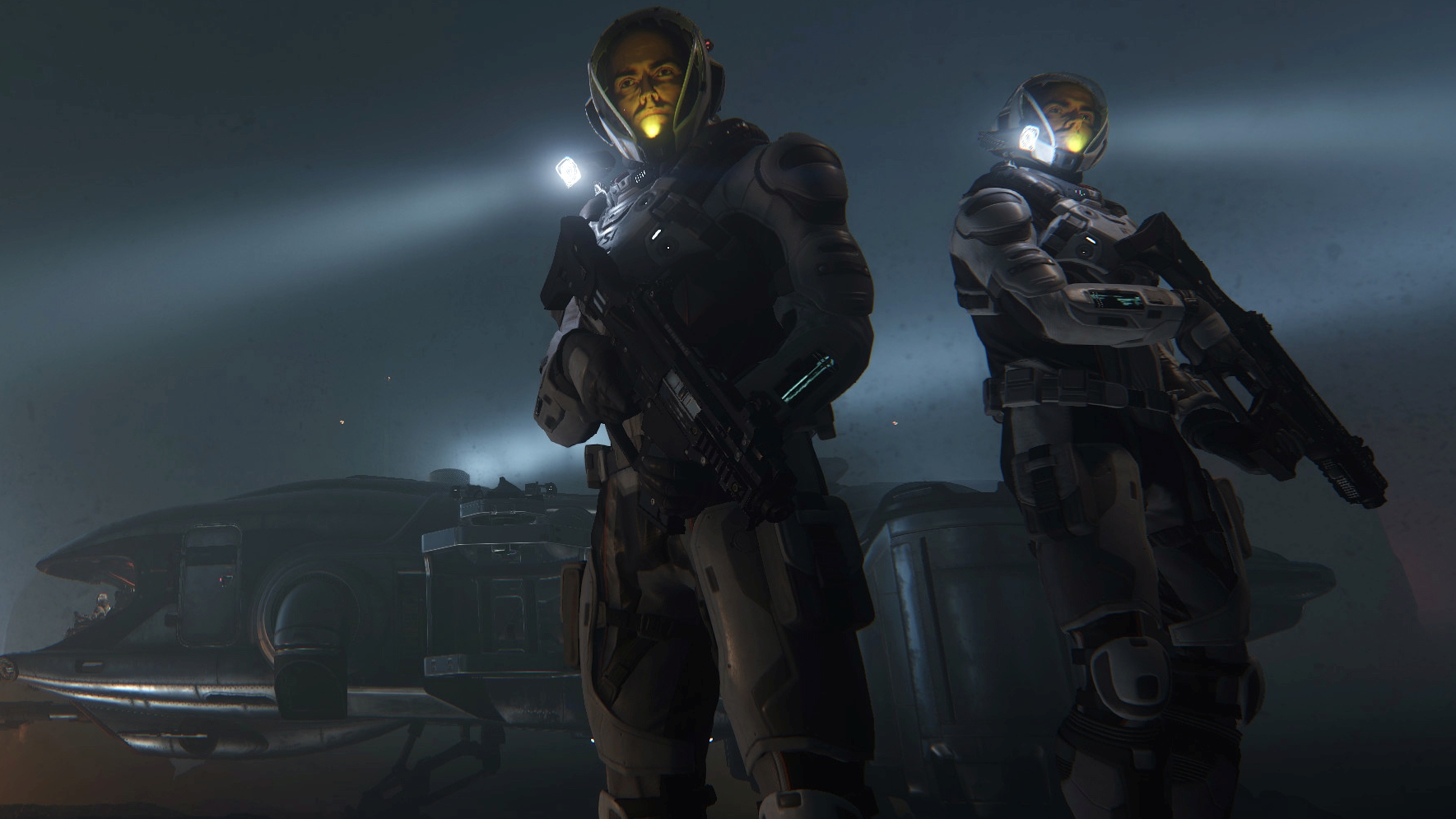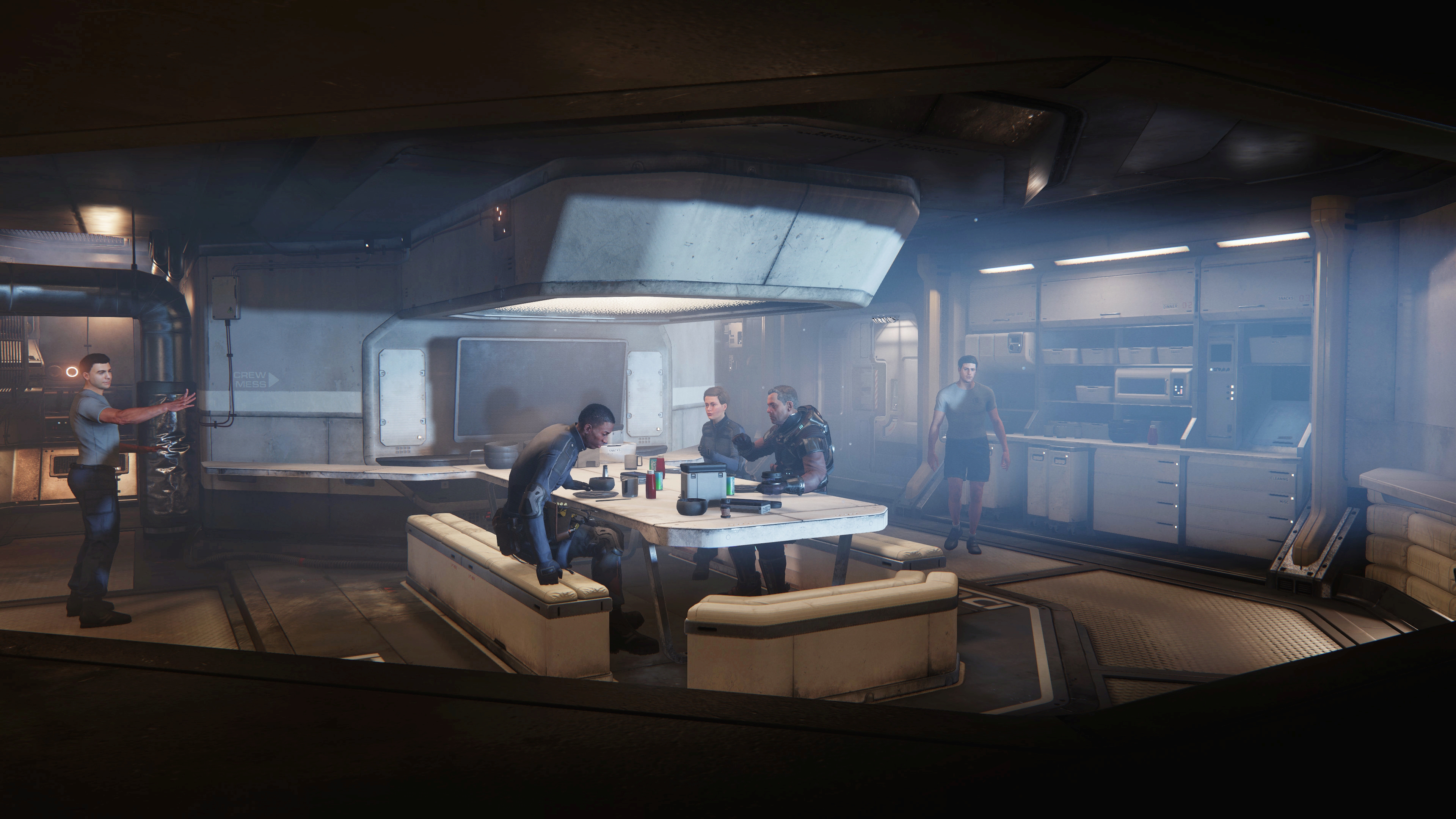Star Citizen: expressive faces, space fashion, and boldly going beyond 3.0
The most ambitious PC game in development gathers pace.
Star Citizen is starting to really take shape. We're sat side-by-side in the middle of the developer's booth, flanked by six of the CIG team, each in control of their own characters in-game. Chris Roberts and I watch the action through the eyes of individual players via a screen in front. "I'd say we're moving from trying different parts of how the game will play, to something that's closer to early access,” says Roberts. “Of course we've still got loads and loads of content to add."
My hands-off demonstration begins with the player hauling himself out of bed and standing in his pyjamas. Pulling up his smartwatch-inspired mobiGlas, devices which are new to update 3.0, he cycles through numerous clothing options that players are said to now have "full control over."
In something akin to Fallout's Pipboy (although more streamlined), a number of other apps display things like the player's heart rate, details on the external atmosphere, and something the game calls the 'Active Status System' which tracks your current loadout, mission statuses, vehicle ownership details and other idiosyncratic information specific to individual players. Should you tire of your default rig the option to buy new clothes from vendors is now possible, but I'll get to that later. Hitting F pulls up the game's new interaction mode, which now highlights everything you can engage with.
One of the most intriguing features of the mobiGlas widget is how players view others as they tinker with their stats in real-time. While clicking around your wrist-mounted tool's options, other players can spy on what you're up to. Roberts says an example of this might involve one player accepting an assassination contract that the target could become aware of simply by looking over the recipient's shoulder.
"In terms of proper persistence—so in terms of your player items, vehicles, inventory, money—it's all constant. If your ship gets damaged, you'll need to earn money to repair it, that's why you'll be doing missions. Banking your money can also be done in 3.0. It has a more traditional game loop." Roberts adds that as well as clothes, players can now also buy weapons and various ship items. In 3.0, players can't yet buy ships themselves—however that's expected in update 3.1, whenever that may be.
The first character in my demonstration is joined by another, and, after accepting a mission from NPC Miles Eckhart (who you may recall from last year's Gamescom presentation), the pair make their way to the armory. While browsing for guns, Roberts delights in showing off two features which I'm told won't feature in 3.0 but "will be added afterwards". 'Faceover IP' is a real-time motion and expression-tracking system, while 'Diogenic IP' captures player voices and models the distortion that in-game obstacles and distance would realistically create.
At present it's a little rough around the edges, but watching players converse with one another, waving, nodding, yawning, in real life and seeing it instantly mirrored in a game like this is impressive. Shopping for guns isn't the most exciting of tasks, but the thought of sidestepping voice chat when out on an assassination mission, for example, and instead opting to use hand signals to overcome your enemy sounds really exciting.
Keep up to date with the most important stories and the best deals, as picked by the PC Gamer team.
After loading up on hardware, the demo's duo stick on their space suits and find their way to a Rover space vehicle. From here, they drive out into the atmosphere and aboard a much larger spacecraft, where they meet another colleague. The demonstration is set on Levski, a free free-town built in one of Nyx's abandoned mining platforms. It looks gorgeous from the outside, and the omnipresent asteroids hanging in the sky above offer a real sense of this world's potential scale. Pulling up the universe's to-scale map on the mobiGlas outlines the moons and planets in the immediate vicinity, and in turn underscores the potential scope of the finished universe.
We take off and set off for Daymar to meet up with our remaining comrades. But before going into hyper drive the game bug, which prevents me from seeing the "seamless transition" from planet-to-planet Roberts so often brags about. I'll take Chris' word on this one, though, and I am however shown a landing and disembarkation by the remaining team members in isolation. To further demonstrate the scale of Star Citizen at this stage, two of the remaining three crew members purposefully leave one teammate behind and we watch as his ship becomes but a shining spec in the sky.
In the middle of it all, I must admit it's hard not to get caught up in the hype of what Star Citizen is: as an idea, a concept and, realistically, a game that won't be finished any time soon. The demonstration I'm shown has clearly been rehearsed despite Roberts and his colleagues' best efforts to make it seem organic—and the bug that prevents us from continuing in one continuous sitting serves to highlight the fragility of its current state.
Nevertheless Star Citizen looks fantastic, and the fact that all this will be possible, all going to plan, within the same server blows my mind. It's made what feels like leaps and bounds since its Gamescom showing last year, and while keen to avoid tying himself to a specific date, Roberts reckons his September 4-8 estimate for the arrival of alpha 3.0 is about right.




